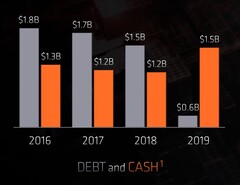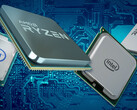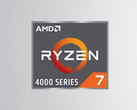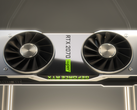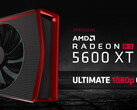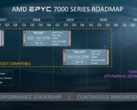Revenue between 2016 (pre-Ryzen) and 2019 increased from US$4.3 billion to US$6.7 billion, and operating margin followed suit by increasing from 1% to 12% over the same time frame (31% to 43% gross). Perhaps the most telling sign of improvement is the change in cash and debt levels. AMD moved from US$1.3 billion cash and US$1.8 billion debt in 2016 to US$1.5 billion cash and US$600 million debt in 2019, with almost all that improvement happening during 2019.
While it would be easy to take a PC-enthusiasts perspective and assume that consumer parts have driven this growth, the most substantial growth area has been with datacentre products, and this trend is predicted to continue. General PC products are the second-highest area of growth, with high-end gaming products only expected to have a small revenue uptick over the next few years. This reflects the appeal of AMD's high core-count EPYC processors, with impressive performance and comparatively affordable pricing. EPYC is used in large datacentres owned by Microsoft, Google, Amazon, and more. Google's largest cloud data centre uses EPYC 2, and the Archer2 supercomputer will use around 12,000 of these CPUs
The Bulldozer microarchitecture (and derivatives) used through most of the 2010s was leading AMD towards progressively worse results each year. This was despite having the exclusive contract to provide the APUs for both the Xbox One and Playstation 4 and having decent sales in the low-to-mid-range dGPU market. It is good to see AMD's position strengthening because of the carry-over effect that competition has on prices and generational improvements.
I grew up in a family surrounded by technology, starting with my father loading up games for me on a Commodore 64, and later on a 486. In the late 90's and early 00's I started learning how to tinker with Windows, while also playing around with Linux distributions, both of which gave me an interest for learning how to make software do what you want it to do, and modifying settings that aren't normally user accessible. After this I started building my own computers, and tearing laptops apart, which gave me an insight into hardware and how it works in a complete system. Now keeping up with the latest in hardware and software news is a passion of mine.
> Expert Reviews and News on Laptops, Smartphones and Tech Innovations > News > News Archive > Newsarchive 2020 03 > AMD details much stronger financial position at their 2020 Financial Analyst Day
Craig Ward, 2020-03- 8 (Update: 2020-03- 8)




